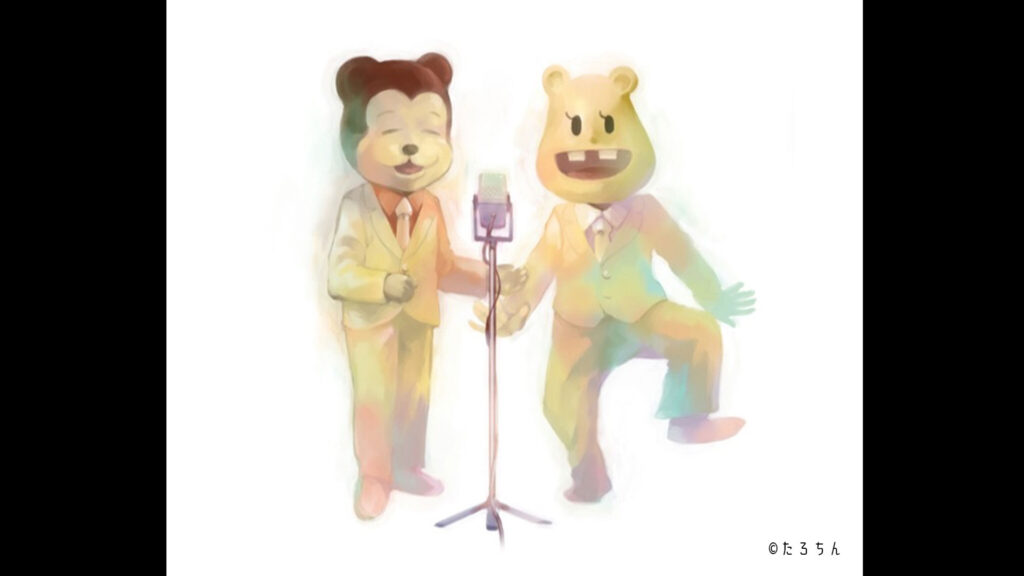自身の作品にこだわりを持つ若手クリエイターtoubou.(相馬路子)さんとスクーターフィルムズが出会ったことで生まれた短編アニメ映画『さざ波の少女たち』。
業界の実績的には全く未知数のコンビながら、クロアチアの「ザグレブ国際アニメーション映画祭」で上映されるなど既に世界的に注目を集めています。
インタビュー後編では作品制作におけるこだわりや、創作を「呪い」と捉える独特な価値観を語ってもらいました。

インタヴュアー:たろちん
1985年生まれ。本名・大井正太郎。 2008年、ニコニコ動画で「たろちん」としてゲーム実況を開始。Webニュースサイト「ねとらぼ」のライター・編集者を経て、現在フリー。お酒をこよなく愛する人間だったが、2022年に「重症急性膵炎」という大病を患い膵臓の3分の2が壊死する。現在は生涯禁酒の身。
作品を完成させるコツは「気合い」 クリエイターの“意地”によって生まれる信頼関係
――toubou.さんの才能と熱意に惹かれてスクーターフィルムズとのチームが結成されたわけですが、短編アニメ映画『さざ波の少女たち』が生まれるまでにはどんな経緯があったんでしょう?
芦塚:「まずは短編で」というのは自然に決まりましたね。
toubou.:そうですね。私の力量的にもぽっと出の素人がいきなり2時間の映画を作れるとは思ってなかったので、現実的なゴールとしてまずは短編を完成させようと。
――作業的にはどんなところから?
芦塚:最初は迫田さんがtoubou.さんにヒアリングをしながら脚本を整理していきました。「この部分が起承転結だね」とか映像化するにあたってのセオリーなどを話しながら脚本を掘り下げていって、キャラ設定などが出来上がっていった感じです。
原田:「ストーリーは欲しいよね」という話は結構しました。卒制で作った予告編はtoubou.さんのイマジネーションの湧く部分を選んで絵にして繋いでいく、という発想だったと思うんですが、短編とはいえ映画にする以上は物語の構成がしっかりないと観客には届けられないよね、と。そこは丁寧にやっていきました。

――toubou.さんとしては初めてチームを率いる監督という立場を担ったわけですが、そのあたりの苦労などはありましたか?
toubou.:私がVコンを毎日ちょっとずつ作って皆さんに投げて、という作業をしていた時期なんですけど、その時は私がこの作品の答えを全て握っている状態じゃないですか。自分しか持っていない答えをどうやって人に伝えようっていうのはずっと悩んでいました。
作画の打ち合わせでも、私の作品なのに私が説明できないことがあったら作業者さんにとても迷惑になるなとか。毎回会議が終わってから1人で反省会をして落ち込んでました。
――それはまさにチームで動く監督ならではの悩みですね……。
toubou.:卒制だと私が締め切りに間に合えばいいので、究極やっつけでもどうにかなるんです。でもチームで作るとなると、私が答えを出さないと動けない時間が増える人がいる。そういう自分が見えていないところまで想像することの難しさをすごく感じました。
――しかもいきなり「監督」ですもんね。
toubou.:そうですね。ましてや私は今までアニメを作っていたわけでもない、突然やってきた素人なので、「その差は私が埋めるしかない!」と思って必死にやってました。
1度途中でパンクしそうになった時、迫田さんに「あなたが答えを出さないと進まないよ」ということを言われて。私としては目の覚めるビンタをくらったような気持ちですごく響いたのを覚えています。
――その辺りは経験のあるスクーターフィルムズの皆さんが導いてくれたという感じなんですね。
芦塚:迫田さんが要所要所でスパルタでしたね。「まだこんなにあるよ。どうするの?」って。
toubou.:私も「ここまでやったのに全部おじゃんになったらどうしよう」という恐怖がありました。あと、個人的に何か指摘されたら次はめちゃくちゃそれが改善されてるくらい行動で示したいという負けず嫌いな部分もあって。
――結果を出せばぐうの根も出ないだろうと。
芸大に行くときも親に「どうせ受験に落ちるだろう」と思われていたので合格して入学させるしかないって状況を作ったし、大学で「絵を仕事にするなんてできるの?」と言われたときも「もう仕事でお金をもらってます!」って言えるようにしました。それは自分がやるしかない部分。だから「作品を完成させるコツは?」って聞かれたら「気合いです」って答えます(笑)。
――なるほど(笑)。一番強いやり方というか、クリエイターに必要な気質ってそういうところなのかなとも思いますね。
原田:本当にその通りで、我々もその意地があったから信頼できたんです。やっぱり映画1本作るのってめちゃめちゃ大変なことなので。負けず嫌いっておっしゃいましたけど、こちらも死ぬ気で描いてくれてるなと思いました。でなければ全ての背景を1人で描くなんてできませんから。
――それをやりきったことで両者の信頼関係もより強固なものになったと。そのほか、制作中に印象に残ってることはありますか?
芦塚:実は今回、制作段階ではtoubou.さんの声でセリフを当てたVコンを作ってもらったんです。そしたらtoubou.さんの声がぴったりすぎて。
――へー、監督自ら仮のセリフを入れたんですね。
toubou.:私は何度も嫌だと言ったんですよ(笑)。本当に無理難題を言うなあと……。
芦塚:でも音響監督もすごく褒めていました。「toubou.さんの声が正解だから声優が声を当てるとむしろ違和感が出ると思う。その違和感をなくすために頑張ります!」って言ってたくらいです。
――自分ではやらないようなことをやるというのもチームで制作するからこそという感じがしますね。
toubou.:確かにスクーターフィルムズの皆さんと作っていく中で、自分の作品なのに自分の気付かなかった部分の解像度が上がっていくというのはすごく感じました。私の中では有馬遥というキャラクターは純粋無垢なかわいい女の子を描いたつもりだったんですけど、芦塚さんに「遥って実はあんまり性格よくないよね」って言われて、あっそうじゃなかったんだ、みたいな。
寅谷倫のほうも最初は淡々としたクール系な女の子をイメージしていたんですけど、作品を作っていく中でどんどん人間味のあるエネルギッシュな子になっていって。それは自分1人で作っていたら絶対にそうはならなかったので嬉しい誤算でしたね。
――そのあたりのやりとりというか、制作は基本的にリモートで行われたんですか?
芦塚:そうですね、toubou.さんは青森の自宅から定期的にオンラインで会議に参加して。うちのアニメーターも引っ込み思案な子が多くて、最初は作画打ち合わせでもカメラもマイクもオフ、みたいなことが多くてtoubou.さんもちょっとアウェイ感を感じてしまってたんじゃないかと思うんです。
それで一時期、打ち合わせを「MetaLife」という仮想オフィスでやったことがありました。ドット絵のアバターがWeb上の会議室に集まって通話するというものなんですけど、それだと人見知りな子たちでもなんとなくお互いのキャラクターが伝わるのか結構喋るようになってくれて。
――なるほど、アニメ制作ってそういう部分にも工夫があるんですね……。
原田:引っ込み思案が多いから工夫したというのはスクーターフィルムズの特殊事例かもしれません(笑)。
toubou.:でも私もスクーターフィルムズに所属してやれることや考えることが増えたし、1人じゃない心強さというのは本当にあって。こうして青森にいながらでも楽しさや充実感を味わえていて大変ありがたいです。
シネスコという画角へのこだわり 「鑑賞物として見てほしい」
――そういえば『さざ波の少女たち』は本編だけでなく卒業制作の「予告編」のときからシネスコで作られていましたが、あれはtoubou.さんのこだわりですか?
toubou.:卒制は最初、普通に16:9で作ってたんですけど、私の背景が映えるのはシネスコだなと思ったんです。
――YouTubeであんなに横長の画角の動画を観るのが珍しいなと思って印象に残りました。
toubou.:16:9の画角ってよくも悪くも既視感がすごいんですよ。「鑑賞物を見ている」という感覚を出したかったので、あまりなじみのないシネスコの画角にしました。そのほうが没入感はなくなると思うんですが、自分と鑑賞物という隔たりを感じて欲しいなと。
――なるほど、最初からそういう哲学があるところがまさに「やりたいことが定まっている」というところなんでしょうね。
原田:シネスコは横に広すぎて構図を作るのが難しいから嫌われるほうの画角だとは思うんです。それを絵としてちゃんと成立させているのはむしろ特徴になるのかなと思いました。
あと没入感という話が出ましたが、今後「Apple Vision Pro」みたいなデバイスが一般的になって、それで見たら逆に相当没入感があるんじゃないかなとも思います。
――『さざ波の少女たち』の制作期間はどのくらいだったんですか?
原田:2022年11月から2024年2月くらいまで。なので大きく「足掛け3年」と言ってましたが(笑)、実際には1年強で制作しました。
――『さざ波の少女たち』はザグレブ国際アニメーション映画祭などで上映が決まりましたが、日本ではまだ観られる場所が決まっていないんですよね。(※2024年7月時点)
原田:短編映画って制作だけでなく公開の難しさがあるんです。映画館で短編が1本だけ上映されることってないし、ネット配信するにしてもなかなか展開の仕方が難しくて。
――確かに短編1本だけ見る機会ってなかなかないですね……。
原田:なので映画祭というのは絶対に外せない場所として作り始めた当初から意識していました。日本国内の映画祭にも応募しているのでそのあたりは今後お知らせできればと思っていますが、もともとtoubou.さんの作品やアートは海外の人に伝わりやすいと思っていました。海外には短編の映画祭がたくさんあるのでちょうどいいなと。
芦塚:ザグレブは「世界3大アニメ映画祭」の1つで非常に大きな場所なので、ここに出られるのは非常に嬉しかったですね。
作品を出すことは「呪い」 『さざ波の少女たち』で描かれるtoubou.さんの情念
――初作品がそういう大きな舞台で上映されることについて、toubou.さんとしてはどんなお気持ちですか?
toubou.:正直よくわからない……。
――(笑)それはまだ観た人の反応とかもないので実感が湧かないという感じですか?
toubou.:そうですね、「ほんまか?」みたいなところもあるし(笑)。この作品を完成させることが私の第一終着点だったので、その先のことを想像できないという状態が今も続いているという感じなんです。
そもそも「この作品で名を上げてやろう」とか「売れたい」みたいな欲は全くないので……。私がちょっと変な人であることが徐々に世に放たれていくんだろうなっていう……。
芦塚:でもtoubou.さん、映画が完成したとき「私が世界に見つかっちゃいますね」って言ったんですよ(笑)。
――そこだけ聞くとめちゃくちゃ野心家みたいに聞こえますね(笑)。
toubou.:あー……でも、私は作品を出すことは「呪い」だと思ってるんです。作品を出すということは自分の生きてきた痕跡を広く散らして誰かの中に植え付けていく行為だと思っていて。作品を通して自分の分子がみんなの隙間にちょっとずつ入っていって、最終的にみんなの記憶にずーっと残ってる人になりたい。それが人生の最大のプロジェクトみたいなところはありますね。
――すごいな、それは確かに「呪い」ですね……。なんか単に「売れたい」とかよりよっぽど大魔王感のある野望に感じます。
toubou.:危険思想かもしれない(笑)。
芦塚:我々は本当に「その意気やよし!」って感じなんですよね。
toubou.:やっぱり誰かの記憶とか記録に残っていないとその人が生きていたことって徐々に薄れていってしまうと思うんです。作品を作ることができる、つまり自分の存在や気持ちを知ってもらう能力があるのならそれはやっていきたいなと思っています。
――なるほど。それも全てのクリエイターに通じる話かもしれませんね。
芦塚:個人的になんですが、toubou.さんって性格がいいわけじゃない……っていうとアレですが(笑)、「情念」みたいなものは作品の中で印象的なセリフになって描かれていると思うんですね。そこが監督のクセというか人間として面白い部分になっているなと。
toubou.:『さざ波の少女たち』を観れば私のことがわかる、という作品になっていると思います。遥は私の片割れですし、倫は「こういう友達が欲しかった、今の記憶を持ったまま次の人生を送れるならこう生きたい」という希望を具現化している部分があります。
――早く日本の方にも観てもらいたいですね。この作品は「さざ波プロジェクト」として今回の映画以外にもさまざまな展開を予定しているそうですが、具体的にはどんなものがあるんでしょう?
toubou.:現在は公式サイトのほうで毎週新しいイラストと文章を発表しています。映画では描かれていない「さざ波」の世界を表現しているので、この世界はまだ広がっているということを感じてもらえればと。
原田:「さざ波」の世界には遥と倫以外にもいろんな人が暮らしているということは表現していけたらと思っています。今回の映画に参加したアニメーターの1人がもともとtoubou.さんのファンで世界観を理解していたので、彼女とtoubou.さんで新しく30秒の映像も作っていたりします。
北海道の新千歳空港のサイネージで上映するごく短い映像の映画祭があって、そこに参加できたらいいなと。「さざ波」と地続きの世界観で、今度は正方形の画角の映像になるのでまた違ったことができればと思っています。
――期待しています。最後に、大きな仕事を一つ終えたtoubou.さんは、今後の作品に向けてどんなことを思っているのでしょう?
toubou.:私は自分の中で湧き上がる感情を1人で抱えておけなくて、その時々で作品にしてお焚き上げをしていると思っていて。自分の感情を作品にして、燃やして、供養して、区切りをつけるというやり方をしてきたので、「さざ波」を描き切った今はわりと「無」の状態なんですよね。だから次にどうするかというのがまだわからなくて……今は皆さんすみませんと思いながら生きているんです(笑)。
――なるほど。でもそれはいいことですよね。自分が助かりたくて作品を作って、実際に助かったわけですから。
toubou.:そうかもしれません。私は常に自分が描きたいことを描き切ったらそこが自分の終わりだろうなという気持ちで刹那的に生きているんですが、しばらくしたら今の「無」の期間も作品にしたいと思うのかもしれません。
作品を作ることが自分自身の延命になっているというか、そのために自分が生きているというか。私はきっと絵が描けなかったらくたばっているタイプの人間なんですが、世界を愛したくて、それを見つけたいがために作っているんだろうなと。これからもそういうことを思いながら作品を作っていくんだろうなという気はしています。
(終わり)


